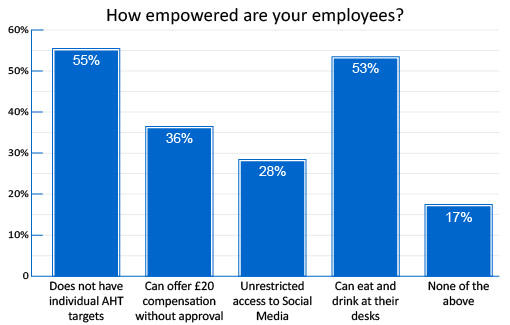In this next part of our Contact Centre Manifesto series, we explain how to involve the frontline in operational and strategic decision making.
The problem
Companies struggle to identify customer problems when contact centre agents already know what they are
Too often, management teams choose to spend precious budget on customer surveys, customer focus groups, and consultants – instead of talking to the frontline.
Not only is this a terrible waste of knowledge and talent, as frontline agents talk to customers all day about the problems that customers are experiencing, but ignoring the information and insight of the frontline also has a clear negative impact on morale.
It is naïve to think that the small team “above” knows more than the big team “below”.
Everyone assumes someone else is taking care of it
Frontline staff also struggle when it comes to kicking up a fuss about a problem, either assuming someone else is taking care of it, or that it isn’t their job to mention it, or not knowing who to tell and how to tell them so that something will be done about it.
The impact of this missing or delayed insight will vary between organisations. For example, in a warehouse-focused operation, insight about products regularly breaking, or a product being continually out of stock, can be immediately useful (or damaging) to a business. Yet this won’t be so urgent for a service which fields questions about council tax rates every day.
Overall, getting feedback from agents about what is happening in the world as inhabited by customers can help improve the contact centre and the wider business – and should not be overlooked!
Agents aren’t empowered or taught to think outside the box
There is also the issue of agent empowerment, which is the ability and willingness to support the wider business.
The graph below shows some of the limitations agents experience in the contact centre, showing, for instance, that only a third can offer compensation without approval:
What can we do about this?
Breed a culture of communication and ownership across the business
Making the decision to involve agents in strategy isn’t as simple as flicking a switch. It is about taking positive steps forward to breed a culture of communication and ownership across the business.
The end goal should be a frontline team that fully understand their role in the wider business and feel respected enough to put forward their suggestions. This needs to be partnered with a management team that trusts and acts on this insight.
This will empower agents to share their views on operational (and perhaps sometimes strategic) improvements, for the benefit of the wider business – and ultimately the customer.
A three-pronged approach will help you involve agents in operational and strategic thinking
With the help of some of the leading experts in the contact centre industry, we’ve outlined a three-pronged approach to help you to change your company’s culture and better support the involvement of agents in operational and strategic thinking:
- Introduce initiatives that support regular communication with the frontline
- Engage agents in exercises that focus on the strategic goals of the business
- Nurture good relationships between the contact centre and the wider business
1. Introduce initiatives that support regular communication with the frontline
Encourage agents to report on and take ownership of problems
A lot of agents suffer from “that’s not my job” syndrome
It can be hard to spot exactly where the problems are in your business if no one wants to talk about them.
If your agents are being a bit too quiet, it may be that they are suffering from “that’s not my job” syndrome; where employees encounter problems in their day-to-day work but think it is another department’s responsibility to fix them – and consequently do nothing.
This can be an expensive mistake for everyone involved, especially if agents are handing out compensation to “patch up the issue” instead of reporting its root cause.
A reporting system can capture specific problems impacting the customer experience
One way to encourage agents to voice their concerns is to set up a reporting system on your company’s intranet page. This should be separate from a more general suggestions box and capture specific problems affecting your customers’ experience of your processes, products and services. It can also help to look at the reasons why agents are giving out compensation.
Once your frontline buy in to the idea that “it isn’t my job to fix it, but it is my job to report it and keep an eye on whether it has been fixed or not”, you should be able to better support a culture of continuous improvement in your contact centre.
Agents will be more fulfilled if they are proactively involved in serving customers
“Agents hear and see the issues all the time. Let them take ownership in getting them dealt with, both internal to the centre (this system doesn’t work well) or outside (getting lots of complaints about a certain product),” said Richard Snow at Ventana Research. “They need to be more proactively involved in ‘serving customers’, which will be more fulfilling, which will make them happier, which will result in happier customers.”
It isn’t practical to expect agents to take end-to-end ownership
“Empowering agents to put forward ‘change requests’ and escalate a problem to a floor walker are great initiatives to have in place,” said Carolyn Blunt at Real Results Training. “However, it isn’t practical to expect agents to take complete end-to-end ownership, as being on the phones all day makes it near-impossible for them to achieve this.”
Set up a “suggestions box” and regularly review agent input

A “suggestions box” reminds the frontline you care about what they have to say
Putting a “suggestions box” on the contact centre floor is an easy, informal way to invite agents to share their thoughts with the rest of the business. (By way of contrast, a reporting system is a more formal channel for agents to highlight problems that someone needs to sort out.)
There are also digital alternatives – such as Yammer and Salesforce Chatter – that offer a less outdated approach.
Some agents may never use the “box”, but knowing it is there can remind the frontline that you do care about what they have to say.
Managers need to take an active interest to encourage continuous feedback
It is equally important that the management team takes an active interest in the suggestions made, setting aside time each week or month to review all the suggestions made and feedback as to why they will or won’t be taken forward.

Carolyn Blunt
“Rewarding the people responsible for the best suggestions is also a good way to keep people engaged in feeding their ideas out to the wider organisation,” said Carolyn Blunt at Real Results Training. “One idea is to give out ‘ideas hero’ lanyards, so everyone knows they’ve put forward a good idea. It can also help to have a ‘Star of the Month’ award for the best idea.”
Alternatively, you could consider setting up a system whereby co-workers are fairly rewarded financially for the savings generated by their suggestions.
If agents just see the box overflow, with no action being taken, they won’t bother putting forward their ideas – and will assume you don’t really care about what they have to say.
It’s not just about what you do with the ideas, but fundamentally about what you do with the value created by those ideas.
Create a community forum so agents can discuss problems with different departments
An internal community forum can enable open conversations with the wider business
Giving frontline agents access to an internal community forum can allow them to have open conversations with the wider business. This could be hosted on a private Facebook page, for example.
The forum can be used to raise problems impacting the day-to-day customer experience and engage the wider business community in discussing possible solutions.
“People are happier working in groups, and results are achieved quicker and are better,” said Richard Snow at Ventana Research. “Get agents out of their cubicles and working together – even if it is electronically.”
Management teams can regularly check in on what is being said on the forum and follow up with the key contributors to help action any solutions.
Free-for-all access will ruin the opportunity for everyone
Creating an internal community forum can be an effective way for different departments to collaboratively discuss the issues impacting customers. However, it involves proper management of channelling certain calls (through the IVR) to a specific team of people who then have access to a specific department.
For example, these calls go through to a smaller more experienced team, who can go into After Call Work (ACW) and liaise with experts/ other departments.
If this is an option open to every advisor to try and communicate with every department, it will probably just become noise. Too many interruptions from the call centre can be disruptive and lead to the call centre being ignored… And the resource being useless to everyone!
Create a “Big Brother” diary room for agents to share their thoughts
It can be difficult for agents to work up the confidence to sit down and talk to their team leaders about the problems they see in the business.
One way to break down this communication barrier is to set up a “Big Brother” diary room, where agents can talk directly to the camera instead of to a person. (Also invite your agents to record their video contribution in groups of 2 or 3, if they’d prefer.)
To set up your “Big Brother” diary room, all you need is a video camera and a designated room for recording in.
Once captured, you can send this employee feedback footage to other departments in the business, such as Marketing or Human Resources, to prompt change. Snippets of film can also make great visuals in the boardroom when trying to make a case for improved technology, seating or canteen options.
Involve agents in projects that play to their strengths

Determine your agents’ strengths
Everyone brings different strengths into the contact centre. Taking the time to find out what these are – and involving agents in projects that play to their strengths – can benefit the contact centre twofold:
- Agents gain an increased sense of purpose in the business
- Brainstorming exercises benefit from a broader range of opinions
For example, an agent with management experience from a previous company might be able to put forward some plausible suggestions for addressing employee engagement, while an IT student might have the understanding to look at how your current IT systems could be improved.
“People like to be stretched, but not too far,” said Richard Snow at Ventana Research. “Get agents involved in things they are happy doing and good at – and the results will be much better.”
You can determine agents’ key strengths and interests through questionnaires and one-to-one meetings.
Provide a career path into the rest of the business
The contact centre can act as a breeding ground for talent. If properly managed, involving agents in such projects can be a great way to feed them out into the wider organisation.
However, this sort of programme needs to be managed carefully to benefit the contact centre as a whole. Moving agents out too early poses a risk of time being wasted training someone on the floor only to have to replace them 3 months later.
Beware picking favourites and breeding resentment
This kind of programme can work well as a reward strategy. For example, after 12 months of good performance on the contact centre floor, agents can put themselves forward for selection in external projects.
Fair assessment is especially important here. It shouldn’t just be a case of managers hand-picking their favourites.
You also need to ensure those who are unsuccessful are given feedback and kept on a reserve list for the next selection process, otherwise you could risk breeding jealously and ill-feeling on the floor.
For more ideas like this for managing your people, read our article: Customer Service Begins With Employees
Gather daily insight
Targeted questions can be answered with a show of hands
A “little and often” approach is a great way to show agents you value their opinion.
One way to gather regular feedback is by asking targeted questions in your daily briefing sessions that can be answered with a quick “shout out” or show of hands.
For example, “how is the new break schedule working out?”, “have you had any problems with your technology this week?”, or “what have customers been calling in about today?”.
Stop relying on employee feedback being captured just once a year
This approach will help to show your agents that you care about their thoughts every day – not just the one day a year that you expect them to fill out an Employee Engagement Survey.
You can also get some really quick wins out of listening to frontline staff and making changes accordingly.
A focused and well-managed system is key to success
However, these “daily insight” sessions need to be well managed with some direction and focus, otherwise you’ll always hear the loudest people complaining about the same things.
You also need to be careful that agents are being fairly paid for their time at the start and end of their shifts, and for the value that their input generates.
2. Engage agents in exercises that focus on the strategic direction of the business

Agents need to understand the impact of their role outside of the contact centre
Giving the frontline a voice is a good first step in engaging agents in the wider business, as well as capturing valuable insight that can help to improve the customer experience.
However, it is also important to engage the frontline in regular activities that widen their understanding and involvement in the overarching strategy of the business as a whole – beyond the confines of the contact centre.
Here are some ways you can do this:
A combination of the below can help support broader understanding of business strategy in the contact centre.
Ask agents to weigh up the pros and cons of different goals and objectives
One way to involve agents in strategy is to take some of the strategy-making process outside of the boardroom.
For example, once the board or management team has decided on possible goals and objectives for the year, it can be a useful exercise to discuss these with the frontline, before the plans are finalised.
There are two ways to approach this:
- Email/ Intranet – Email the different proposals to every agent or upload them to your company intranet system, then ask each member of staff to vote on their preferred method. You can also ask for input supporting their decision to determine the strengths and weaknesses of each set of ideas.
- Representative focus group – Alternatively, you can gather a small representative focus group in a conference room. The different strategies can then be presented in turn, before opening the discussion to which will work best. Just make sure the quietest people also have a fair chance to have their say!
The findings can then be taken back to the boardroom with a firmer understanding of how these different strategies could impact the frontline and the customer – instead of the strategies just being based on the views of a handful of people.
This approach can also help improve buy-in from the frontline when introducing new systems and processes to support new business objectives.
IMPORTANT: Before beginning this exercise, you need to decide how this input will inform the final decision – and what happens in the event that your agents disagree with the proposal – in order to properly manage everyone’s expectations.
Teach agents the foundations of business planning
It can also be beneficial to set aside some time in the training calendar to specifically teach the foundations of business planning. You can even lay some groundwork in your Induction.
This can help to engage the frontline in the wider business processes as well as help your management teams make a head start on succession planning (by gauging agent interest in the “bigger picture”).
Key topics to cover include:
- A definition of strategy
- An introduction to the managers currently responsible for implementing business strategy – either through photos or in person
- Why strategy is important to everyone – including the contact centre
- How strategy is successfully implemented through goals and objectives
- How strategy is developed and reviewed in your organisation
- The strategies currently in place in your organisation
This learning can be supported by giving agents some mock business problems to work through in small groups to help them understand the practicalities of the planning and implementation process. This can help to improve buy-in to ideas and processes (and understanding budget restrictions) in the short term.
Make the company strategy available to everyone in an accessible format
It is equally important to make sure that the current company strategy – including goals and objectives – is available to anyone who wishes to read it.
This should be formatted in a way that is accessible to everyone, with a key to help less experienced employees decode the company’s internal lingo.
Team leaders can then openly discuss the strategy with agents in their one-to-one meetings, in the context of how their role feeds into the bigger picture.
Regularly host focus groups to review the current strategy in place
Strategy is an ongoing process which requires regular review and input to keep the business on track for success.
You can help to highlight the importance of this to the frontline by hosting monthly or quarterly focus groups to discuss how things are progressing and if anything needs changing.
Key questions to ask include:
- Are the set goals and objectives successfully supporting our current strategy?
- What can we do to address any weaknesses?
- Have any new possibilities emerged? For example, opportunities for offshoring, and new technologies such as voice recognition.
- Do you think we should change direction to embrace these new possibilities and keep up with our competitors?
Even though these appear to be high-level questions, agents will be picking up on how customers are thinking and feeling about your company – and how they feel about your competitors – on a day-to-day basis.
If an agent feels it is part of their job to feedback on any new developments, they will likely have a sharper ear for customer comments that could be putting you behind your competitors.
Invite agents to imitate Dragons’ Den within the confines of a realistic budget
A good way to encourage agents to think about how new ideas feed into the overarching business strategy is to give them the opportunity to pitch to the management team – in imitation of BBC’s Dragons’ Den.
This exercise could be completed as part of an away day.
Read our article Is Your Contact Centre in Need of an Away Day? for more information about hosting an away day for your contact centre team.
The most important thing to do is to ask them to develop their ideas within a fixed (and realistic) budget that also aligns with the company’s existing financial situation.
This should prevent them from creating “pie in the sky” concepts about an office filled with hammocks, iPads and video technology, and give them the framework to home in on what aligns with the overarching business strategy and budget.
Allow agents to assist with product design
It is agents who speak to clients’ day-in and day-out, getting to know the likes and dislikes of the product that their business delivers.
So, in many cases, agents will see a design that has recently been issued and immediately sense that it is or is not what their customers wanted.
A lot of developers actually struggle to find out what customers want and how they use a product, so they think I have to invent what I think what they would like. By using agents, you can eliminate such uncertainty.
Whilst designers and engineers will not always take all the comments on board, some get incorporated into the design process.
So, the contact centre is being used to give strategic thoughts to developers.
This technique can also be used in the formulation of advertising campaigns, business strategies and process development schemes.
3. Nurture good relationships between the contact centre and the wider business

Contact centre managers need to step up to improve cross-department relationships and make their agents’ opinions count
Unfortunately, the success of initiatives to support regular communication with the frontline and engage agents in exercises that focus on the strategic direction of the business depends on how well the contact centre communicates with the wider business.
This responsibility largely falls to the Contact Centre Manager, who will be able to shift the culture of the business somewhat by taking the time to effectively capture the voice of the frontline but won’t be able to successfully use this insight to inform the wider business strategy if they only have the power and influence to make changes within the contact centre.
Here is an example (focused around agent feedback on call volumes) which highlights the limitations of the traditional role of the contact centre manager:
Contact centre problem – An agent says “When I sign on in the morning there is always a huge queue. Why don’t we start the shift half an hour earlier?” It is within the Contact Centre Manager’s control to review and alter shift patterns to help better meet the demand of call volumes, so this issue can be effectively resolved.
Wider business problem – An agent says “When I sign on in the morning, I receive lots of calls from customers ‘still waiting to hear back about their cancellations’.” The root cause of this problem is in another area of the business, so unless the Contact Centre Manager has well-established influence in that area, it will be outside their control to address it.
Both of these sources of information are valid, but will need to be acted on in different ways to produce positive outcomes that better align with the company’s customer experience objectives.
Decide what the role of the frontline is in informing business strategy
It is important to decide what the role of the frontline is in creating the wider business strategy.
There are a few different options available, depending on the culture of your business and the leadership style of the CEO:
1. Frontline feedback is incorporated into boardroom brainstorming
One approach to involving the frontline in strategic decision making is to empower agents to share their views electronically as a part of a wider feedback process.
This insight is then taken into the boardroom to help the company directors to develop their strategy based on real situations instead of developing theoretical and isolated strategy.
You could structure this more formally by advertising the time and date of the next board meeting and inviting feedback accordingly.
2. The CEO delivers a strategic statement and seeks input
Another approach is for the business leader to set occasional challenges to the wider business (including the contact centre) by delivering a strategic statement.
For example, “We’re not going to go offshore, but we need to make those same savings. How do you propose we do this?”
Employees then have a deadline to return their proposals for possible solutions.
You can make this more straightforward by giving agents a business proposal framework to work with, including:
- What is the idea?
- How will it work?
- Who will be involved in implementing and supporting the idea?
3. Give agents some breathing space so they have time to investigate issues
Over-managing agents with strict schedules and targets can overload them and restrict their creativity. Instead, think about how you could ease the pressure on agents’ schedules.
For example, switching agents between channels that are less demanding than being on the phone (e.g. social media) during the day can give them some of the free rein they need to dig a bit more into a problem.
In this set-up, the role of the agent is not just to complete transactions but to gather and analyse information. In this way, agents can be an intelligent cog in a reactive, organic business strategy.
However, this kind of thinking can’t be done “between the cracks”. You need to set aside solid blocks of time and resources to make this a worthwhile exercise.
IMPORTANT: Make sure you are inviting the right people to work on these projects, otherwise you risk insulting the people who have progressed to a management level to solve such problems, and humiliating the people who don’t have the relevant knowledge.
It can be a lifetime’s work to overhaul the culture of a business
Successfully feeding frontline insight into the wider business is about building mutually beneficial, cross-department relationships.
This can be a lifetime’s work, requiring the intelligent use of data, stories, influencing skills, design of information flows, and decision-making meetings to make the wider business respect and take action with the voice of the frontline.
However, with the right attitudes in place:
- In 3 months… Something will have changed
- In 12 months… The way things generally work will have changed
- In 24 months… The culture should have been overhauled
For more information on how to get buy-in from the board and give the contact centre a voice, read our article How to Get Skilled in Creating a Business Case
Traditional business models can slow down progress
The traditional capitalist business model is structured around the people at the top driving the strategic decisions – focusing more on the stock market than what is happening on the frontline of the business.
A board with this mindset will be far harder to change than one with the mindset of a newer company or a board consisting of people who have previously worked in a more collaborative environment – such as a start-up.
The level and speed of change will also depend on how far into the future your industry and particular business is. For example, companies already embracing new technologies such as business analytics will be far more likely to embrace change.
You need to go back to “Why are your customers getting in touch?”
Driving a collaborative mindset into any business goes back to the foundations of “Why are your customers getting in touch?”
For more information on how to find out why your customers are getting in touch and use this information to your advantage, read our article Really Understand Why Your Customers Are Contacting You
If you really understand and cleverly manage data structures and develop the best ways of using stories and data across the business, things will improve.
A situational example:
A contact centre manager gets beaten up every Monday morning by the board about the drain of cost the contact centre is on the business.
The following Monday, the same manager goes in and instead says, “Everything is fine with attendance and schedule adherence, but we are currently dealing with an unexpected spike in calls due to the actions of the man on the other side of the table who started a marketing campaign without letting us know!”
This shift in focus, combined with really strong data and stories and an ability to convince and influence people, will be a step-change in the way the business is run.
It is hard, but it will be worthwhile in the long run.
Final thoughts
Agents do have a role to play as a valuable source of information and insight in the development of ongoing operational and strategic thinking. It is up to the contact centre manager to make sure their voice is heard.
This article forms part of The Contact Centre Manifesto series
The following ideas have been discussed with members of the CCMA, and the following industry experts:

[left to right] Peter Massey at Budd, Carolyn Blunt at Real Results Training, Ann-Marie Stagg at the Call Centre Management Association (CCMA), Guy Fielding at horizon2, and Richard Snow at Ventana Research.
Author: Robyn Coppell
Reviewed by: Megan Jones
Published On: 22nd Jun 2016 - Last modified: 13th Jan 2025
Read more about - Customer Service Strategy, Career, Carolyn Blunt, Contact Centre Manifesto, Editor's Picks, Employee Engagement, Feedback, Peter Massey, Richard Snow, Training


















